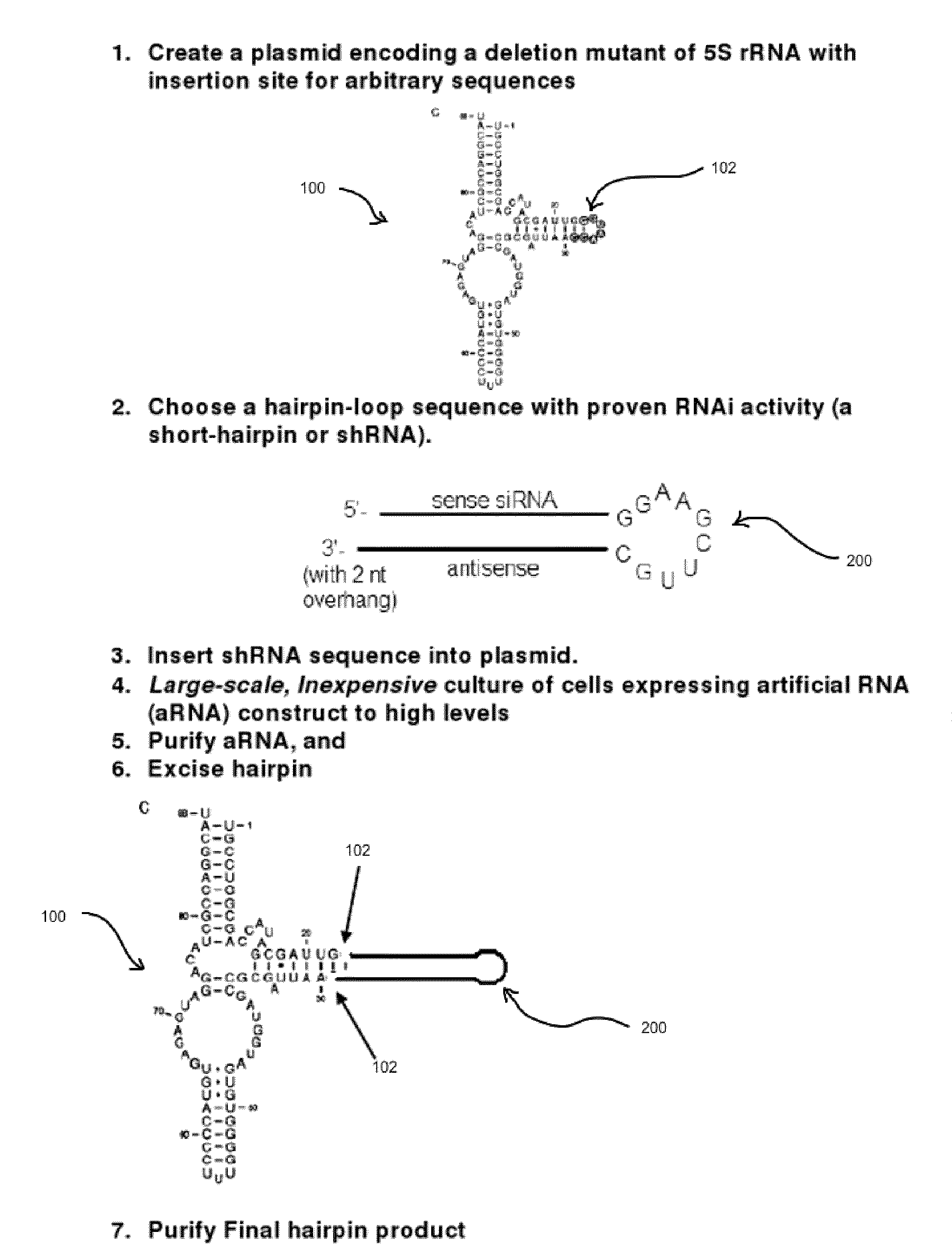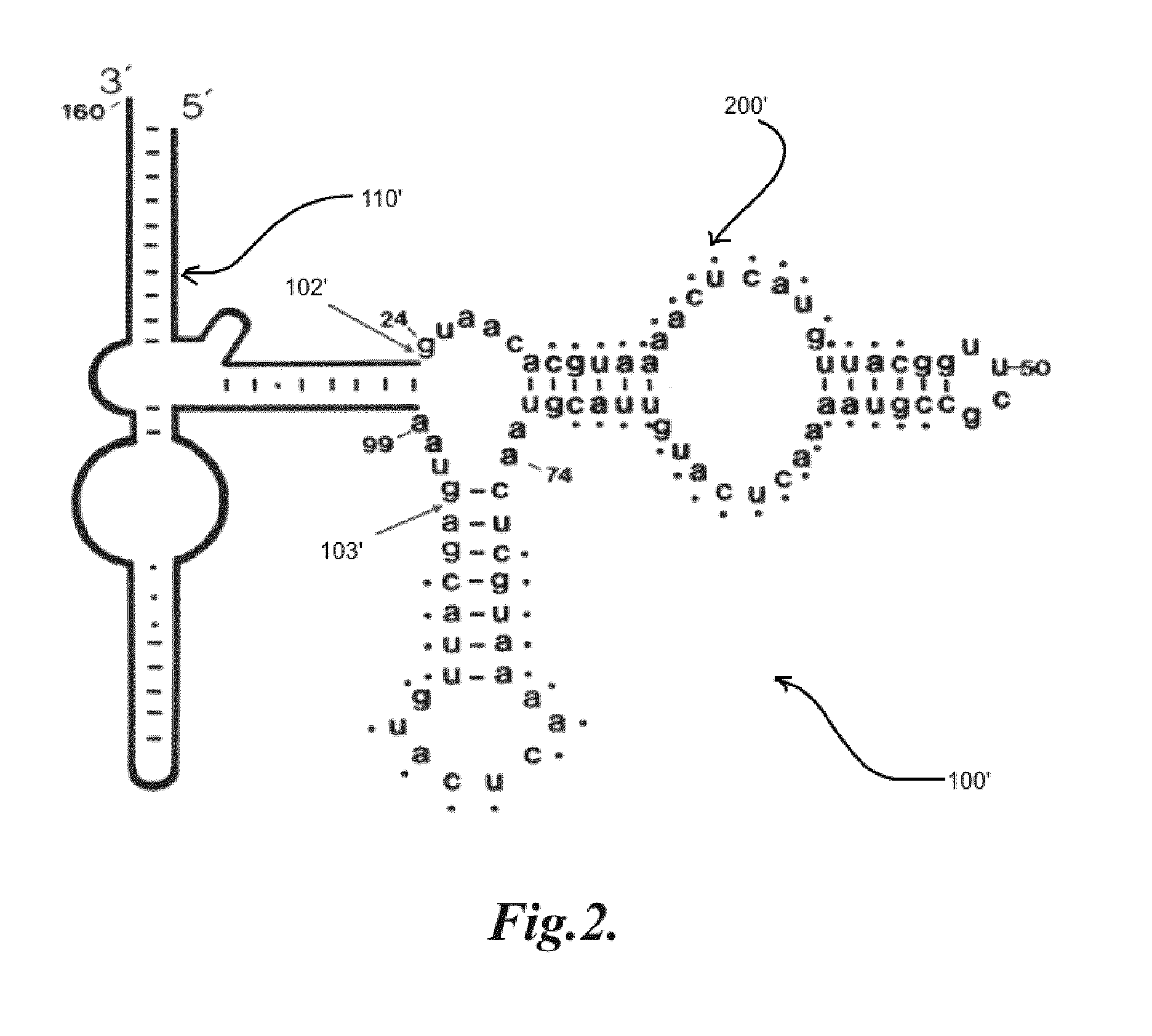Functional nucleic acids and methods
a nucleic acid and functional technology, applied in the field of functional nucleic acids and methods, can solve the problems of prohibitive yield and cost of in vitro transcription or chemical synthesis of rna at very large scale, and achieve the effects of high yield, easy culture, and high production of nucleic acids
- Summary
- Abstract
- Description
- Claims
- Application Information
AI Technical Summary
Benefits of technology
Problems solved by technology
Method used
Image
Examples
example 1
Chromosomal Modification for Encoding Randomized Sequences within Modified rRNA
[0079]A plasmid-based system for expressing random libraries of RNA sequences within the context of a larger 5S rRNA sequence will be used. While this system has some advantages in terms of being selectively inducible by IPTG and can be used to readily identify new aptamers, the desired strains should be chromosomal variants. This is mainly because for the water or solids waste applications, it would be undesirable to maintain a plasmid system by the continual addition of an antibiotic. Described below are steps to create a very similar system residing on the chromosome of E. coli.
[0080]In order to introduce the necessary genetic modifications the protocol as described in Ammons et al. will be followed. See Ammons D, Rampersad J, Fox G E: A Genomically Modified Marker Strain of Escherichia coli. Current Microbiology 1998, 37:341-346. The aRNAs containing the random RNA libraries within the 5S rRNA will b...
example 2
Chromosomal Integration of the Randomized aRNA Library
[0081]The protocol to be used for gene replacement will be as described in Ammons et al. See Ammons D, Rampersad J, Fox GE: A Genomically Modified Marker Strain of Escherichia coli. Current Microbiology 1998, 37:341-346, which has been derived from Link et al. See Link et al Methods for Generating Precise Deletions and Insertions in the Genome of Wild-Type Escherichia coli: Application to Open Reading Frame Characterization. Journal of Bacteriology 1997, 179(20):6228-6237. Briefly, EMG2 cells are transformed with the pKO3-SARP-derived plasmids containing the aRNA library, obtained by subcloning. A single transformation colony is then plated on a yeast tryptone (YT) agar plate containing chloramphenicol (80 ug / ml) and incubated at 42° C. The pKO3-SARP plasmid confers chloramphenicol resistance but is temperature sensitive and thus, cannot replicate at 42° C. Only the cells in which the plasmid has integrated into the chromosome wi...
example 3
PCR, Cloning, and Sequencing for Verification of Random Library Strains
[0082]To verify that our randomized aRNA library has been inserted into the E. coli chromosome several primers that have been described in Ammons et al. will be used. Primers A (CCCGAGACTCAGTGAAATTG) (SEQ ID NO:1), B (CCCAAGAATTCATATCGACGGC) (SEQ ID NO:1), C (CCCAAGCTTCGCTACTGCCGCCAGGCA) (SEQ ID NO:3), and D (TCCCCCGGGAGTAGGGAACTGCCAGGCAT) (SEQ ID NO:4) are nonspecific and hybridize to orthologous regions present in all seven rRNA operons. Primer E (GGCTCTCTTTCAGACTTGGG) (SEQ ID NO:5) is specific for rRNA operon H. PCR amplification using primers A and E will allow for the discrimination between an aRNA gene insertion and a wild type 5S rRNA gene and this will be evident by standard electrophoretic analysis. The amplified sequence would then be cloned using the TOPO TA system (Invitrogen) to be subsequently sequenced with the expectation that the randomized region will generate many indeterminate base-calls or “N...
PUM
| Property | Measurement | Unit |
|---|---|---|
| Fraction | aaaaa | aaaaa |
| Fraction | aaaaa | aaaaa |
| Fraction | aaaaa | aaaaa |
Abstract
Description
Claims
Application Information
 Login to View More
Login to View More - R&D
- Intellectual Property
- Life Sciences
- Materials
- Tech Scout
- Unparalleled Data Quality
- Higher Quality Content
- 60% Fewer Hallucinations
Browse by: Latest US Patents, China's latest patents, Technical Efficacy Thesaurus, Application Domain, Technology Topic, Popular Technical Reports.
© 2025 PatSnap. All rights reserved.Legal|Privacy policy|Modern Slavery Act Transparency Statement|Sitemap|About US| Contact US: help@patsnap.com



